Unveiling the smoke and mirrors of conventional wisdom: Why your startup needs a reality check
Introduction: The Metrics Mirage
In the high-stakes world of startups, success is often measured by the same yardsticks used in established companies: revenue, profit margins, and headcount. But for early-stage businesses operating in uncharted waters, clinging to these traditional metrics is like navigating a stormy sea using a map meant for dry land. Every startup founder has experienced that nagging pressure to “hit the numbers”—the investor’s gaze, the mentor’s benchmarks, the quarterly goals that seem to define make-or-break moments. Yet, as many have painfully discovered, these metrics can be not just unhelpful but downright dangerous.
The problem is simple: what works today, might be entirely irrelevant tomorrow. In an evolving Start Up landscape where agility trumps predictability, founders need to break free from the conventional success paradigms. This isn’t just about managing cash flow or generating profit; it’s about redefining what success truly means for an organization that’s still finding its identity.
Picture this: You’re at a swanky startup conference, surrounded by founders bragging about their skyrocketing user numbers, impressive funding rounds, and hockey-stick growth charts. You nod along, feeling that familiar twinge of inadequacy. But here’s the kicker – half of these “unicorns” will be extinct in 18 months, while that quiet founder in the corner, the one nobody’s talking to? She’s building a sustainable business that’ll outlast them all.
Welcome to the wild world of startups, where conventional wisdom is about as useful as a chocolate teapot. We’re living in an age where vanity metrics reign supreme and everyone’s chasing the next big headline. But let me let you in on a little secret: those traditional metrics you’ve been obsessing over? They’re about as relevant to your startup’s success as your HSC score is to your love life (not very relevant today, but then it was the only metrics that mattered).
In this no-holds-barred guide, we’re going to rip apart the startup playbook, set fire to those outdated KPIs, and redefine what success really means in the rollercoaster world of entrepreneurship. Buckle up, because it’s time to face some uncomfortable truths and embrace a new way of measuring what truly matters.
The Illusion of Traditional Metrics: Smoke, Mirrors, and Bullsh*t
The Outdated Scorecard
The obsession with traditional KPIs like revenue, profit margins, and headcount can mislead startup founders into making decisions that stifle innovation and growth. Take, for instance, the fixation on revenue growth. It’s not uncommon for early-stage companies to chase top-line growth at the expense of long-term value creation. When every decision is tied to hitting quarterly targets, startups often end up burning resources to gain customers that aren’t truly aligned with their product — leading to low lifetime value and high churn rates.
Similarly, focusing on profitability too early in the game can stymie the necessary experimentation that drives breakthrough innovation. A startup may forego investments in product development or customer feedback loops, opting instead for quick, revenue-generating initiatives that have no staying power. While profitability is crucial, obsessing over it in the early stages is like trying to plant a tree by pruning its roots.
Remember when your parents told you that good grades would guarantee success in life? Well, traditional business metrics are the startup world’s equivalent of that well-meaning but misguided advice. Revenue, profit margins, user acquisition costs – these are the golden calves that most founders worship at the altar of success. But here’s the thing: in the chaotic, fast-paced startup ecosystem, these metrics are about as useful as bringing a knife to a gunfight.
“Measure what shapes your future, not what validates your past. Traditional metrics tell you where you’ve been – meaningful metrics show you where you can go. The difference between the two is the difference between survival and thriving.”
Let’s take revenue, for instance. In the traditional business world, it’s the holy grail. But in startup land? It can be a false prophet. Just ask any of the countless startups that scaled too quickly, burned through cash like it was going out of style, and imploded spectacularly – all while their revenue charts were pointing to the moon.
Why Old-School KPIs Fall Short
The problem with these traditional metrics is that they were designed for a different era, a time when business environments were more stable and predictable. But startups? They’re like trying to build a ship while sailing through a hurricane. The old rules simply don’t apply.
Take user acquisition costs. In a stable market, it’s a solid indicator of marketing efficiency. But for a startup disrupting an industry? It could be wildly misleading. You might be spending a fortune to acquire early adopters, but if they’re the right ones – those who’ll evangelise your product and drive organic growth – that high cost could be the best investment you ever make.
The Danger of False Positives
Perhaps the most insidious aspect of relying on traditional metrics is the false sense of security they can provide. You might be hitting all your KPI targets, patting yourself on the back, while your startup is actually heading for an iceberg.
Remember Juicero? The $400 juicer startup that raised $120 million in funding? On paper, their metrics looked great – strong sales, impressive user growth. But it turned out people could squeeze their juice packs by hand, rendering the expensive machine useless. All those fancy metrics couldn’t save them from becoming a cautionary tale in startup hubris.
The truth is, in the startup world, success is often counterintuitive. What looks like failure on a traditional scorecard might be the pivotal learning experience that propels you to eventual success. And what looks like success? Well, it might just be the beginning of the end.
“The most dangerous number in a startup is the one that makes you stop asking questions. Success isn’t found in comfortable metrics, but in the uncomfortable truths they reveal.”
So, if these time-honoured metrics are leading us astray, what should we be focusing on instead? How can we navigate the treacherous waters of startup life without these familiar guideposts?
Hold onto your hats, because in the next section, we’re going to dive into why the startup ecosystem is a different beast entirely – and why it demands a whole new approach to measuring success. Are you ready to have your preconceptions shattered? Let’s go.
The Startup Ecosystem: A Different Beast (The Playing Field Is Uneven)
Unique Challenges of Startups
If traditional businesses are like ocean liners – large, stable, and slow to change course – then startups are more like experimental speedboats. They’re nimble, fast, and prone to capsizing if you sneeze too hard. This fundamental difference is why applying traditional metrics to startups is like trying to measure a cheetah’s speed with a sundial – it’s just not going to give you meaningful results.
Startups face a unique set of challenges:
- Uncertainty is the only certainty: You’re often creating products for markets that don’t even exist yet.
- Resource scarcity: Unlike established businesses, you’re constantly walking a tightrope between growth and running out of cash (:( People still talk and think “Abundance”)
- Rapid pivots: What works today might be obsolete tomorrow. Your entire business model could change in an instant (What works is not permanent).
- Talent wars: You’re competing for top talent against tech giants offering cushy salaries and fancy perks (Established competitors have more resources and better (read sweet) stories).
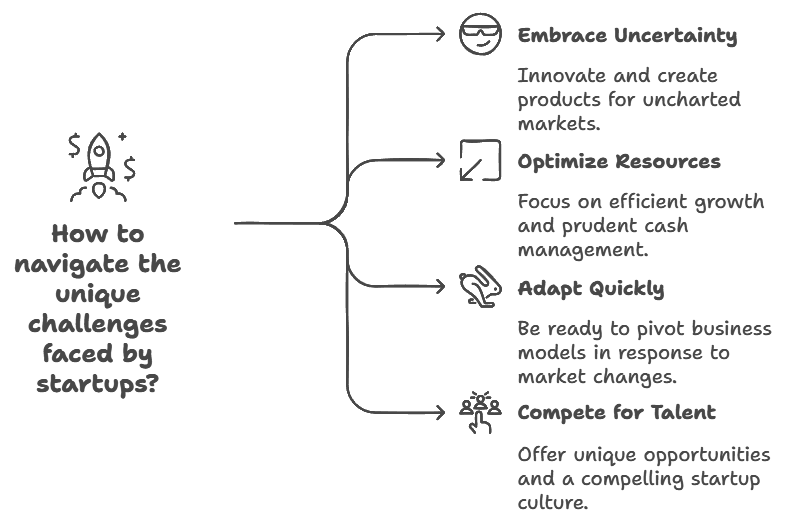
In this environment, clinging to traditional metrics is like trying to navigate through a minefield while staring at your shoes. You might feel like you’re making progress, but you’re one misstep away from disaster.
Why One-Size-Fits-All Metrics Fail
Here’s a radical thought: what if I told you that your startup’s “failure” to meet traditional benchmarks might actually be a sign you’re on the right track? Sounds crazy, right? But in the topsy-turvy world of startups, it’s often true.
Take Amazon, for example. For years, it was lambasted for its lack of profitability. Traditional metrics painted a picture of a failing company. But Jeff Bezos was playing a different game altogether, focusing on long-term dominance rather than short-term profits. We all know how it happened.
The problem with one-size-fits-all metrics is that they assume all businesses are trying to achieve the same things in the same way. But startups are like snowflakes – no two are exactly alike. A B2B SaaS startup will have wildly different indicators of success compared to a direct-to-consumer product startup.
The Need for Adaptive Strategies
In the startup world, adaptability isn’t just a nice-to-have – it’s the difference between thriving and dying. And your metrics must be as adaptable as your business strategy.
This means being willing to throw out vanity metrics that make you feel good but don’t actually indicate real progress. It means being brave enough to track metrics that might make you uncomfortable in the short term but guide you towards long-term success.
For instance, instead of obsessing over user numbers, you might need to focus on user engagement or retention. Instead of chasing revenue growth at all costs, you might need to prioritise unit economics or customer lifetime value.
The key is to develop a set of metrics that are:
- Relevant to your specific business model and stage
- Aligned with your long-term vision
- Indicative of real, sustainable progress
- Flexible enough to evolve as your business evolves
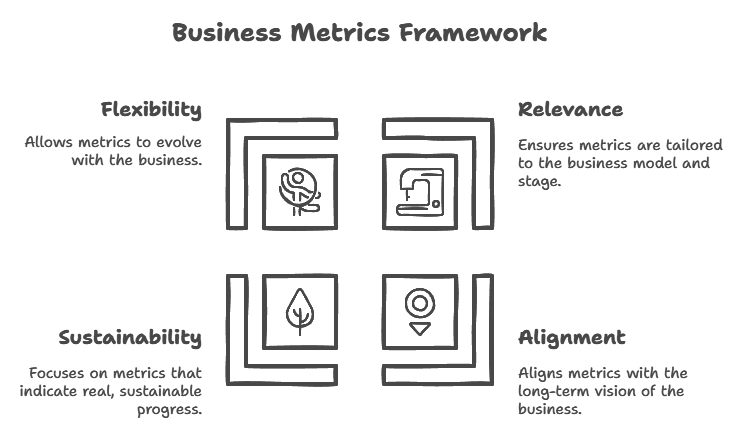
Business Metrics Framework
The Real Cost of Misaligned Metrics
Now, you might be thinking, “So what if I’m tracking the wrong metrics? What’s the worst that could happen?” Well, you are not the first and definitely not the last one to get it wrong. That is the nature of business. So, let me paint you a picture of the startup graveyard filled with the ghosts of companies that danced to the tune of misaligned metrics. However, you may be wrong, but that doesn’t mean you can’t change the course of your approach and follow it through with the set of tactics that will produce different outcomes. It’s that simple. Keep what works; abandon what doesn’t.
Missed Opportunities
When you’re laser-focused on the wrong metrics, you become blind to the opportunities right in front of you. It’s like trying to drive cross-country while only looking at your speedometer – you might be moving fast, but you’re missing all the scenic routes and shortcuts.
Take Blockbuster, for example. They were so fixated on metrics like store revenue and late fees that they completely missed the shift to digital streaming. Meanwhile, Netflix was focusing on metrics like subscriber growth and engagement, positioning themselves perfectly for the future of entertainment.
Resource Drain
Chasing the wrong metrics is like trying to fill a leaky bucket – you’re pouring in resources, but you’re not getting the results you need. This misallocation can be fatal for startups, where every dollar and every hour counts.
Imagine you’re obsessing over reducing your customer acquisition cost (CAC) because that’s what all the startup gurus say you should do. You might end up cutting corners on customer service or product quality to bring that number down. Congratulations, you’ve hit your CAC target! But now your customers are churning faster than you can say “misaligned metrics,” and your long-term growth is in the toilet.
Talent Exodus
Here’s a fun fact: top talent doesn’t stick around in companies that are measuring the wrong things. Why? Because smart people want to work on things that matter, and if your metrics are out of whack, you’re probably focusing on the wrong priorities.
Picture this: you’ve got a brilliant product designer on your team. But instead of measuring the impact of design on user engagement or retention, you’re solely focused on pushing out features to hit arbitrary deadlines. How long do you think that designer is going to stick around before they jump ship to a company that truly values their contribution?
The real kicker? You might not even realise you’re bleeding talent until it’s too late. After all, your metrics tell you everything’s good, right?
So, what’s a startup to do? How can you break free from the shackles of misaligned metrics and start measuring what really matters? Stick around, because in the next section, we’re going to dive into the art of identifying meaningful indicators and aligning your metrics with your long-term vision. It’s time to stop playing someone else’s game and start writing your own rules for success.
Breaking Free from the Metrics Trap
Alright, startup warriors, it’s time to stage a rebellion against the tyranny of misaligned metrics. But before we storm the castle, let’s equip ourselves with the right weapons. Here’s how to break free and start measuring what truly matters.
Identifying Meaningful Indicators
First things first: ditch the vanity metrics. You know the ones I’m talking about – those flashy numbers that make you feel good but don’t actually indicate real progress. It’s time to get brutally honest with yourself.
Ask yourself these questions:
- Does this metric directly relate to our core business objectives?
- Can we act on this metric to drive meaningful change?
- Does this metric give us insight into our customers’ behaviour and needs?
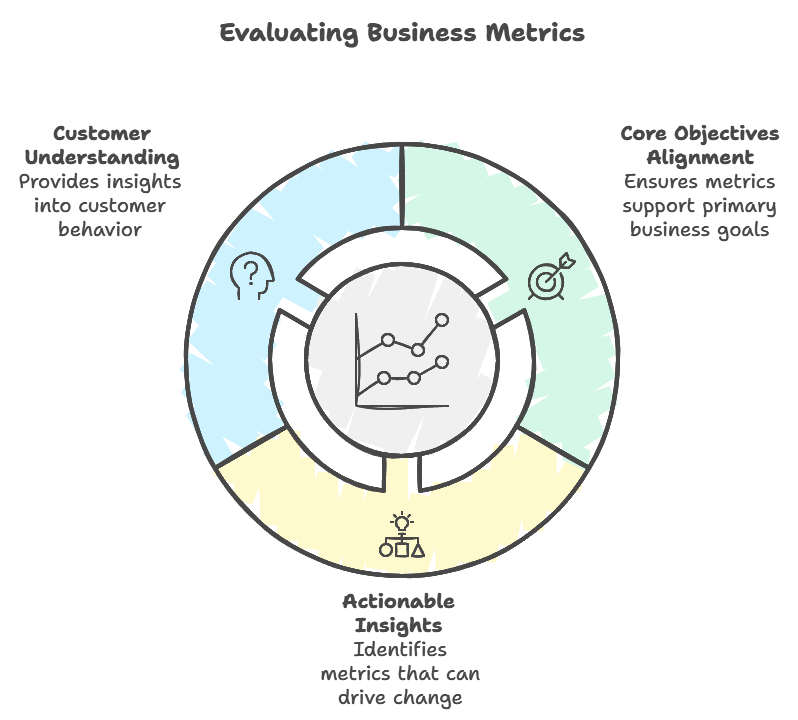
Evaluating Business Metrics
If you answered “no” to any of these, it’s time to send that metric to the guillotine.
“Your startup’s vital signs aren’t measured in dollars and cents, but in problems solved and value created. The metrics that matter most are often the ones you can’t find on a traditional balance sheet.”
Instead, focus on metrics that give you actionable insights. For a SaaS startup, this might mean tracking the activation rate (how many users actually start using your product after signing up) rather than just sign-ups. For an e-commerce business, it could mean measuring repeat purchase rate instead of just total sales. Repetition means super engagement, and super engagement means satisfaction, profits, and long-term success.
Aligning Metrics with Long-Term Vision
Here’s where things get tricky. As a startup, you’re not just trying to optimise for today – you’re building for a future that doesn’t exist yet. Your metrics must reflect that ambition.
Take Tesla, for example. In its early days, if Tesla had focused solely on traditional auto industry metrics like units sold or profit margins, they might have given up before they even got started. Instead, they tracked metrics that aligned with their long-term vision of accelerating the world’s transition to sustainable energy – things like battery efficiency improvements and charging station installations.
So, what’s your grand vision? What metrics can you track today that will indicate progress towards that future state? Don’t be afraid to get creative here. If you’re truly disrupting an industry, your most important metrics might not even exist yet – you might need to invent them.
The Power of Context-Specific KPIs
Remember, your startup is unique (just like everyone else’s). What works for the startup next door might be utterly irrelevant for you. It’s time to embrace your inner snowflake and develop KPIs that are as unique as your business model.
For instance, if you’re running a two-sided marketplace, you might need to track supply-demand ratio in different geographic areas. If you’re developing an AI product, you might focus on the rate of improvement in your algorithm’s accuracy.
The key is to develop a holistic set of metrics that gives you a 360-degree view of your business health, tailored to your specific context and stage of growth.
The New Success Playbook
Now that we’ve broken free from the shackles of outdated metrics, it’s time to write a new playbook for startup success. Buckle up, because we’re about to turn conventional wisdom on its head.
Embracing Adaptability
In the startup world, the only constant is change. Your metrics must be as adaptable as your business strategy. Don’t be afraid to regularly review and revise your KPIs.
Set up a “metrics review” every quarter. Ask yourself:
- Are these metrics still relevant to our current stage and strategy?
- What new metrics do we need to track based on recent pivots or market changes?
- Which metrics are no longer serving us and can be retired?
Remember, clinging to outdated metrics is like navigating with an old map – you might think you know where you’re going, but you’ll end up hopelessly lost.
Focusing on Sustainable Growth
Here’s a radical idea: what if instead of pursuing hockey-stick growth at all costs, we focused on building businesses that can actually, you know, sustain themselves?
This means prioritising metrics that indicate long-term health over short-term gains.
Some examples are:
– Customer Lifetime Value to Customer Acquisition Cost ratio (LTV:CAC)
– Net Revenue Retention (for subscription businesses)
– Burn multiple (how much you’re burning to generate each dollar of ARR)
The goal is to build a business that can thrive in both feast and famine. Because let’s face it, in the startup world, winter is always coming.
Balancing Innovation and Stability
As a startup, you’re walking a tightrope between innovation and stability. Lean too far in either direction, and you’ll lose your balance.
Your metrics should reflect this delicate balance. For every “moonshot” metric tracking your most ambitious innovations, have a “gravity” metric ensuring you’re keeping your feet on the ground.
For instance, you might track:
– Percentage of revenue from new products (innovation)
– Customer churn rate (stability)
– R&D spend as a percentage of revenue (innovation)
– Gross margin (stability)
Keeping an eye on both types of metrics is the way to go because you can ensure you’re pushing the boundaries without flying off the edge of the map.
In our next section, we’ll get into the nitty-gritty of how to actually implement these changes in your startup. Because let’s be honest, theory is great, but execution is everything. Stay tuned for a practical guide on how to audit your current metrics, develop new success indicators, and create a culture of meaningful measurement. The revolution starts now!
Implementing Change: A Practical Guide
Alright, founders and startup enthusiasts, it’s time to roll up our sleeves and get our hands dirty. Talking about new metrics is all well and good, but how do we actually put this into practice? Let’s break it into actionable steps.
Auditing Current Metrics
First things first: we need to take a hard look at what we’re currently measuring. It’s time for some brutal honesty.
- List all the metrics you’re currently tracking. Yes, all of them. Even the ones buried in that spreadsheet no one’s opened since 2018.
- For each metric, ask yourself:
– Why are we tracking this?
– What decisions are we making based on this metric?
– Is this metric driving behaviour that aligns with our long-term goals?
- Categorise your metrics:
– Keep: Metrics that are genuinely useful and aligned with your vision
– Kill: Metrics that are irrelevant, misleading, or driving the wrong behaviour
– Transform: Metrics that have potential but need to be redefined or recalculated
Remember, this isn’t about having a long list of impressive-sounding KPIs. It’s about having a focused set of metrics that actually guide your business in the right direction.
Developing New Success Indicators
Now for the fun part: creating metrics that actually matter for your unique snowflake of a startup.
- Start with your vision. What does success look like for your company in 5 years? 10 years?
- Work backwards. What indicators would show you’re on track for that vision?
- Get specific. Instead of vague goals like “increase user engagement,” define what engagement actually means for your product. Is it daily active users? Time spent in the app? A number of features used?
- Consider leading indicators. While lagging indicators (like revenue) are important, leading indicators can help you predict future performance. For a content platform, this might be something like “number of user-generated posts.”
- Don’t forget about qualitative metrics. Not everything that matters can be quantified. Consider incorporating metrics like Net Promoter Score or customer satisfaction ratings.
Here’s a starter pack of alternative metrics to consider:
– Customer Happiness Index: A composite score of customer satisfaction, retention, and referral rates
– Innovation Velocity: How quickly you’re able to go from idea to implemented feature
– Team Alignment Score: Regular surveys measuring how well your team understands and is working towards company goals
– Market Education Index: Tracking how well you’re creating awareness and understanding of your solution in the market
Creating a Culture of Meaningful Measurement
Now, here’s the tricky part. You can have the best metrics in the world, but they’re useless if your team isn’t on board. It’s time to create a culture where everyone understands and cares about the metrics that matter.
- Transparency is key. Share your metrics dashboard with the entire team. Yes, even the interns. When everyone can see the impact of their work, magic happens.
- Educate your team. Don’t just throw numbers at people. Explain what each metric means, why it matters, and how individuals can influence it.
- Align incentives. Make sure your compensation and promotion structures reward the behaviours your new metrics are designed to encourage.
- Celebrate the right wins. Did you hit a vanity metric but miss a more meaningful target? Don’t break out the champagne yet. Save the real celebrations for achievements that genuinely move the needle.
- Make it visual. Humans are visual creatures. Use dashboards, charts, and graphs to make your metrics impossible to ignore. Bonus points if you can fit your core metrics on a single TV screen in the office.
- Regular check-ins. Have weekly or bi-weekly meetings to discuss your key metrics. What changed? Why? What are we going to do about it?
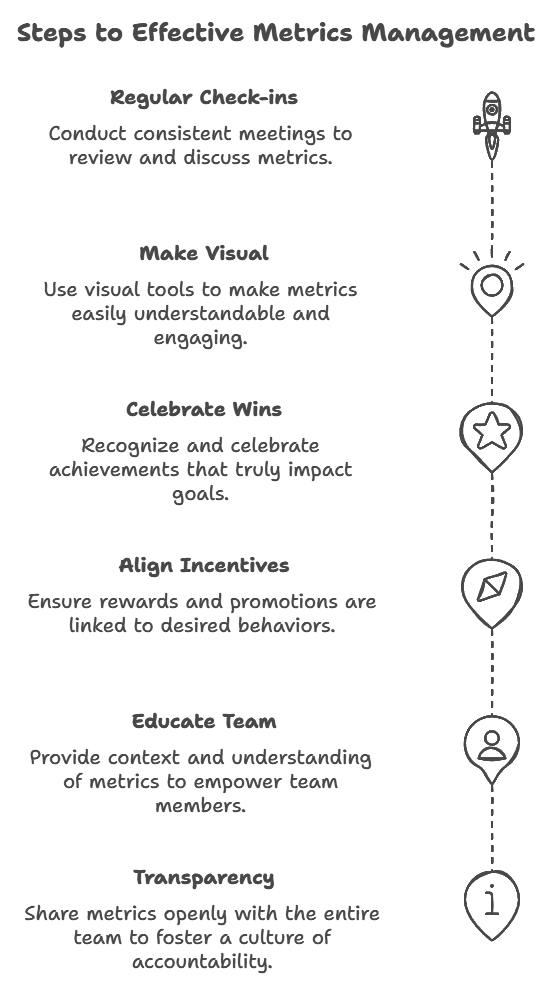
6 Steps to Effective Business Management Metrics Management
Remember, changing your metrics is really about changing your company’s focus and behaviour. It’s not going to happen overnight, and it’s not always going to be comfortable. But trust me, it’s worth it.
The lesson? When you focus on the right metrics – the ones that truly matter for your unique business and vision – you set yourself up for long-term success, even if it means sacrificing short-term hype.
Navigating the Noise: Choosing the Right Guiding Voice
In the cacophony of startup advice, how do you decide which voices to listen to? Here’s a guide to cutting through the noise and finding guidance that actually serves you.
The Problem with Too Many Gurus
Let’s face it: the startup world is lousy with self-proclaimed experts. They’re shouting from every rooftop about the “one true way” to build a successful company. The problem? Most are full of hot air.
Remember, what worked for one startup in one market at one particular time might be utterly irrelevant – or even harmful – for your unique situation. Beware of anyone selling a one-size-fits-all solution.
How to Identify Valuable Advice
- Look for battle scars: Prioritise advice from people who have actually built and scaled companies, not just talked about it.
- Seek context-specific wisdom: The best advice comes from people who understand your specific market, business model, and stage of growth.
- Value principles over tactics: Look for advisors who teach you how to think, not just what to do.
- Beware of survivorship bias: Remember, for every success story, there are hundreds of failures. Seek voices that are honest about both.
Building a Reliable Advisory Network
- Diversify your sources: Don’t rely on just one mentor or advisor. Build a network of voices with different perspectives and experiences.
- Engage with your peers: Sometimes, the best advice comes from other founders in the trenches, facing similar challenges.
- Create feedback loops: Regularly assess the impact of the advice you’re following. Is it actually moving the needle on your key metrics?
- Stay curious but sceptical: Always be open to new ideas, but don’t be afraid to question conventional wisdom.
Remember, at the end of the day, you’re the one in the driver’s seat. Use these voices to inform your decisions, not make them for you.
The Future of Startup Success Measurement
As we wrap up our journey through the world of startup metrics, let’s take a moment to peer into the crystal ball. What does the future hold for how we measure success in the startup world?
Emerging Trends in Performance Evaluation
- Holistic Impact Metrics: Expect to see more startups measuring their impact not just in financial terms, but in social and environmental outcomes too.
- Real-Time Adaptive Metrics: With advances in data processing, we’re moving towards metrics that can adjust in real-time based on changing market conditions.
- Predictive Analytics: It’s not just about measuring what has happened, but predicting what will happen. Expect to see more startups using AI to forecast future performance based on current metrics.
The Role of AI in Metric Tracking
Artificial Intelligence isn’t just for building products – it’s revolutionising how we measure success too. Here are some ways AI is changing the game:
- Automated Insight Generation: AI can sift through mountains of data to surface the most relevant insights, freeing up humans to focus on strategy.
- Anomaly Detection: Machine learning algorithms can spot unusual patterns in your metrics before they become major issues.
- Personalised Metric Dashboards: AI can learn which metrics are most relevant for each team member and customise their dashboards accordingly.
The Rise of Holistic Business Health Indicators
As we move forward, expect to see more nuanced, comprehensive ways of measuring overall business health. These might include:
- Ecosystem Vitality Score: Measuring the health of your entire business ecosystem, including partners, suppliers, and customers.
- Adaptability Quotient: Quantifying how quickly your organisation can respond to market changes.
- Innovation Metabolism Rate: Measuring how efficiently your company can transform ideas into revenue-generating products or features.
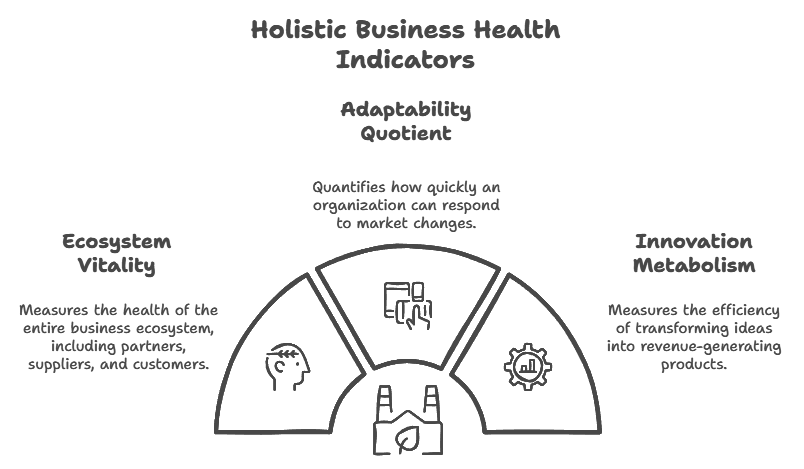
Holistic Business Health Indicators
The future of startup success measurement is about being more holistic, more predictive, and more aligned with long-term value creation. It’s about measuring not just what’s easy to quantify, but what truly matters.
As we close this guide, remember: metrics are tools, not masters. They should inform your decisions, not dictate them. The most successful startups of the future will be those that can look beyond the numbers to see the bigger picture, while still using data to guide their path.
So, brave founder, are you ready to redefine success on your own terms? The future is waiting, and it’s measured in metrics we haven’t even imagined yet. Go ahead and measure wisely!
Conclusion: Charting Your Own Course
We’ve journeyed through the treacherous waters of startup metrics, debunked old myths, and charted a new course. But remember, this isn’t the end – it’s just the beginning of your journey.
The truth is, there’s no one-size-fits-all solution to measuring startup success. What matters is that you’re thoughtful, intentional, and always questioning whether your metrics are serving your ultimate vision.
So, as you sail forth into the wild seas of entrepreneurship, keep these parting thoughts in mind:
- Be brave enough to ignore vanity metrics, even when they’re telling you what you want to hear.
- Stay flexible – the metrics that matter today might not be the ones that matter tomorrow.
- Never lose sight of the human element behind the numbers. Your customers, your team, and your impact on the world can’t always be quantified in a spreadsheet.
- Remember that the most important metric of all is one that’s often overlooked: Are you building something that matters?
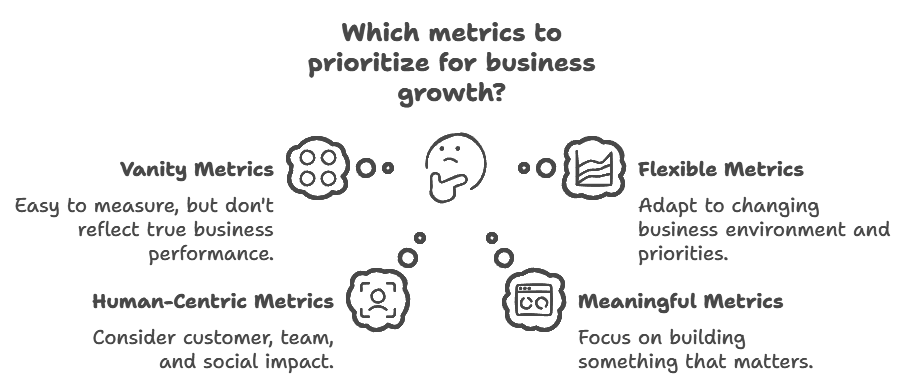
Business Growth Metrics – How We Measure Success?
Now, go ahead and measure what truly counts. The startup world is waiting for leaders who dare to redefine success. Why shouldn’t it be you?
FAQs
- Q: Isn’t ignoring traditional metrics risky? What if investors want to see these numbers?
A: It’s not about ignoring traditional metrics entirely, but rather putting them in context and complementing them with more meaningful indicators. Smart investors will appreciate a thoughtful, holistic approach to measuring your business’s health and potential.
- Q: How often should we be reviewing and updating our metrics?
A: At a minimum, you should be doing a thorough review quarterly. However, in the fast-paced startup world, it’s good practice to have a pulse check on your metrics weekly, allowing for quick adjustments as needed.
- Q: We’re a very early-stage startup. Should we even be worrying about complex metrics at this point?
A: Even at the earliest stages, having the right metrics can guide your decisions and help you validate your business model. Start simple, focus on metrics that directly relate to your current goals (like product-market fit), and evolve your measurement approach as you grow.

